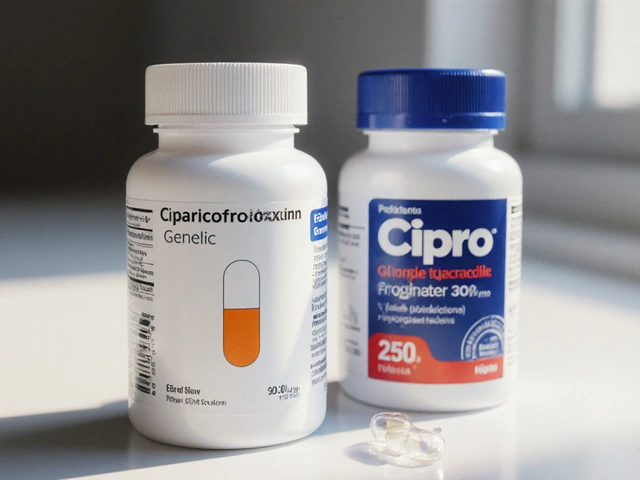Key Takeaways
- Terbutaline is a β2‑agonist used off‑label for stopping early uterine contractions, but its safety profile in pregnancy is controversial.
- Maternal side effects can include rapid heart rate, high blood pressure, and severe anxiety.
- Fetal exposure may raise the risk of low birth weight, abnormal heart rhythms, and neonatal intensive‑care admission.
- Regulators in the US, Australia, and New Zealand now limit its use to short‑term rescue therapy, not routine tocolysis.
- When a clinician prescribes terbutaline, close monitoring, the lowest effective dose, and a clear plan to discontinue are essential.
What is Terbutaline?
When it comes to managing certain pregnancy complications, Terbutaline is a short‑acting β2‑adrenergic agonist that relaxes smooth muscle, most notably the uterus often surfaces in discussions. First approved in the 1960s for asthma, its ability to relax uterine smooth muscle made it attractive for obstetric use.
In simple terms, terbutaline mimics adrenaline at specific receptors (β2) found on the muscle lining of the uterus. By activating those receptors, the muscle fibers relax, slowing or halting contractions.
How Terbutaline Works in Pregnancy
The drug binds to the β2‑adrenergic receptor on uterine smooth muscle cells, triggering a cascade that increases cyclic AMP. Elevated cyclic AMP reduces calcium influx, and lower calcium means the muscle can’t contract as forcefully.
Because the same receptors exist in the lungs, terbutaline also dilates bronchial passages-hence its continued use for asthma. This dual action explains why dosing must be balanced; too much can overstimulate the heart while too little may be ineffective for stopping preterm labor.
Approved Uses and Off‑Label Use for Tocolysis
Regulatory agencies only approve terbutaline for asthma and, in some countries, for short‑term relief of bronchospasm during pregnancy. Its use to stop preterm labor-known as tocolysis-is off‑label.
Historically, obstetricians prescribed a 0.25 mg sub‑cutaneous or intravenous dose every 15‑30 minutes until contractions slowed, then switched to a maintenance dose of 5-10 µg/min. Modern guidelines, however, warn against maintenance therapy lasting more than 48 hours because adverse events rise sharply after that window.

Safety Concerns: Maternal Risks
Maternal side effects are the most immediate red flag. Common symptoms include:
- Tachycardia (heart rates above 130 bpm)
- Palpitations and arrhythmias such as premature ventricular contractions
- Elevated blood pressure, sometimes precipitating hypertensive crises
- Chest tightness, tremor, and severe anxiety
- Hyperglycemia, which can be problematic for women with gestational diabetes
Severe complications-though rare-include myocardial infarction and pulmonary edema. A 2022 Cochrane Review found that women receiving terbutaline had a 1.9‑fold higher odds of cardiovascular events compared with those given placebo.
Safety Concerns: Fetal and Neonatal Risks
Fetal exposure occurs quickly because terbutaline crosses the placenta. Researchers have documented several potential harms:
- Reduced birth weight; a meta‑analysis showed an average 150 g decrease when terbutaline was used for more than 48 hours.
- Increased risk of neonatal intensive‑care unit (NICU) admission-about 22% higher in the exposed group.
- Transient neonatal tachycardia and altered heart rhythm that can persist for days after birth.
- Possible impact on fetal lung maturity, though data are mixed.
One 2024 observational study from New Zealand linked prolonged terbutaline exposure (>2 days) to a 1.4‑times higher rate of respiratory distress syndrome in preterm infants.
Regulatory Guidance and Recent Studies
The US Food and Drug Administration (FDA) issued a safety communication in 2020 restricting terbutaline to short‑term rescue therapy (< 48 hours) for preterm labor. The agency cited over 500 reports of serious maternal cardiac events.
Australia’s Therapeutic Goods Administration (TGA) went further in 2021, recommending that terbutaline not be used for routine tocolysis at all. Instead, clinicians should consider nifedipine or magnesium sulfate first.
New Zealand’s Medicines and Medical Devices Safety Authority (Medsafe) echoed the FDA stance, emphasizing that any use beyond emergency rescue must be documented in a specialist‑level treatment plan.
These regulatory shifts are backed by a growing body of literature. A 2023 systematic review of 12 randomized controlled trials concluded that while terbutaline can delay delivery by an average of 24‑48 hours, the benefit is outweighed by the increased risk of maternal cardiac events and neonatal complications.
Practical Precautions for Expectant Mothers
If your obstetrician prescribes terbutaline, here’s a checklist to keep the risk low:
- Confirm the indication. It should be for acute rescue of threatened preterm labor, not routine maintenance.
- Ask about dosing. The initial bolus should not exceed 0.5 mg, and the infusion rate should stay ≤10 µg/min.
- Monitor vitals continuously. Heart rate, blood pressure, and oxygen saturation need 15‑minute checks during the first hour.
- Limit duration. Document a stop‑time; most guidelines cap use at 48 hours.
- Review other medications. Beta‑blockers, antihypertensives, and certain antidepressants can interact with terbutaline.
- Plan for alternative tocolysis. If contractions persist, discuss switching to nifedipine or magnesium sulfate.
Women with a history of heart disease, uncontrolled hypertension, or thyroid disorders should avoid terbutaline altogether unless the benefits clearly outweigh the risks.
Alternatives to Terbutaline for Preterm Labor
Because of the safety alarms, clinicians now favor other agents that have a better risk‑benefit profile. Below is a quick comparison.
| Agent | Mechanism | Typical Use Duration | Key Maternal Side Effects | Key Fetal/Neonatal Concerns |
|---|---|---|---|---|
| Terbutaline | β2‑adrenergic agonist - relaxes uterine smooth muscle | Up to 48 hours (emergency rescue) | Tachycardia, hypertension, anxiety, arrhythmia | Lower birth weight, NICU admission, neonatal tachycardia |
| Nifedipine | Calcium‑channel blocker - reduces intracellular calcium | 24‑72 hours, often followed by steroids | Headache, flushing, hypotension | Generally safe; slight increase in preterm birth < 34 weeks |
| Magnesium Sulfate | Calcium antagonist - stabilizes neuromuscular junction | Up to 48 hours for neuroprotection | Maternal flushing, respiratory depression at high doses | Neuroprotective for cerebral palsy; safe for fetus |
Most obstetric guidelines now list nifedipine as the first‑line oral tocolytic and reserve magnesium sulfate for neuroprotection in very early preterm births.
Frequently Asked Questions
Can terbutaline be used safely in the first trimester?
The first trimester is a period of rapid organ formation, and terbutaline’s systemic effects (e.g., increased heart rate) can stress the developing embryo. Current guidelines advise against any tocolytic use before 24 weeks unless a life‑threatening situation demands it.
What should I do if I experience a rapid heartbeat after a dose?
Contact your care team immediately. They may pause the infusion, give a beta‑blocker, or switch to a different tocolytic. Do not wait for the next scheduled check.
Is breastfeeding allowed while on terbutaline?
Terbutaline does pass into breast milk in low amounts. Most experts consider short‑term use compatible with breastfeeding, but mothers with a history of cardiac issues should discuss alternatives.
How does terbutaline compare to nifedipine in terms of delaying delivery?
Both can buy an extra 24‑48 hours, enough time to give steroids for lung maturity. Nifedipine, however, carries fewer cardiovascular side effects and is now the preferred first‑line agent in most countries.
Why do some clinicians still prescribe terbutaline despite the warnings?
In some rural settings, oral nifedipine or IV magnesium may not be readily available, and terbutaline’s sub‑cutaneous form is easy to store and administer. In those cases, clinicians must follow strict monitoring protocols.
Understanding the balance between the short‑term benefit of halting a preterm contraction and the long‑term safety of both mother and baby is the heart of the terbutaline pregnancy conversation. By staying informed, asking the right questions, and following evidence‑based precautions, you can navigate this tricky medication landscape with confidence.











Diana Jones
When your provider orders terbutaline, think of it as a high‑impact β2‑agonist that demands tight hemodynamic surveillance. The pharmacodynamic window is narrow, so continuous telemetry and non‑invasive blood pressure monitoring every 15 minutes is non‑negotiable. Pair the bolus with a pre‑emptive beta‑blocker plan to blunt tachyarrhythmias-yes, you read that right, prophylaxis beats panic. Remember, the goal is to buy time for corticosteroids, not to sustain a prolonged rescue mission.
Abbey Travis
Just a heads‑up: if you’re scared of rapid heartbeats, ask for a low‑dose protocol and a clear stop‑time in writing. It helps keep everyone on the same page and reduces anxiety for both mom and baby. The community’s got your back, so don’t hesitate to speak up.
ahmed ali
First off, the whole terbutaline scare is a classic case of “policy over physiology.” The drug’s β2‑adrenergic action is well‑documented to relax uterine smooth muscle, and that fundamental mechanistic fact doesn’t just vanish because of a few case reports. Sure, you’ll see tachycardia, but the transient nature of the response is something any seasoned OB can manage with a simple beta‑blocker like labetalol. There’s also the matter of dosage; most of the adverse events arise when clinicians ignore the recommended 0.25 mg sub‑cutaneous bolus and start pushing continuous infusions at 30 µg/min, which is way above the safety ceiling. If you stick to the FDA‑approved rescue parameters-under 48 hours, max 10 µg/min-the cardiac risk curve flattens dramatically. Moreover, the meta‑analysis that flags a 150 g reduction in birth weight pooled studies with wildly heterogeneous populations, making the absolute impact negligible in most clinical scenarios. Let’s not forget that terbutaline is the only tocolytic that works when you need a rapid IV push, something nifedipine can’t match in an emergency outside a hospital setting. In rural clinics where magnesium sulfate isn’t stocked, terbutaline’s shelf‑stable ampules become a lifeline for both mother and fetus. Yes, the FDA issued a safety communication, but regulatory bodies love to overreact when the media latches onto a few scary headlines. The real world data from community hospitals show that when terbutaline is used sparingly, the NICU admission rates are comparable to baseline preterm cohorts. Also, consider the psychological aspect: telling a woman that “you can’t have a rescue drug” can increase stress, which itself may precipitate more contractions-a paradoxical effect. The notion that terbutaline causes long‑term neurodevelopmental deficits is still speculative; most studies lack long‑term follow‑up beyond the first year. If you’re worried about hyperglycemia, a quick finger‑stick and insulin adjustment can keep glucose in check, just like we do with steroids. So before you throw the drug out the window, weigh the actual evidence against the anecdotal fear mongering. In short, terbutaline remains a valuable tool in the obstetric armamentarium when wielded responsibly, and the blanket bans do more harm than good.
Deanna Williamson
The data cited are cherry‑picked; most trials demonstrate negligible benefit beyond 24 hours. Continuing use feels like an excuse for inadequate staffing.
Carolyn Cameron
One must acknowledge that the discourse surrounding terbutaline is suffused with a lamentable paucity of epistemic rigor. The vernacular proclivity to equate sporadic case reports with causative inference betrays a sophomoric misunderstanding of statistical hierarchy. A perspicacious appraisal would juxtapose pharmacokinetic constancy against the episodic nature of adverse event reporting, thereby elucidating the true risk‑benefit calculus. Hence, to promulgate unequivocal proscription absent such nuance is an act of intellectual myopia.
Ben Durham
From a clinical standpoint, the paramount objective is maternal‑fetal safety, and that starts with meticulous dosing and vigilant monitoring. If you coordinate with a multidisciplinary team, you can mitigate the cardiovascular side effects while still gaining the needed gestational window for corticosteroids. Keep a detailed log of vitals; it’s the simplest yet most effective safeguard.
Barbara Ventura
Terbutaline, when used just as a short‑term rescue, can be effective, provided the dosage is capped, the monitoring is continuous, the patient is informed, and the care team is ready to act, all while keeping an eye on maternal vitals.